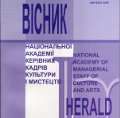ІНТЕРПРЕТАЦІЯ ІСПАНСЬКОГО ТАНЦЮ В СЦЕНІЧНІЙ ХОРЕОГРАФІЇ АНТОНІО ГАДЕСА
Interpretation of Spanish Dance in Antonio Gades’s Stage Choreography
Author(s): Olesya VakulenkoSubject(s): Theatre, Dance, Performing Arts, Customs / Folklore, Cultural Anthropology / Ethnology, Post-War period (1950 - 1989), Transformation Period (1990 - 2010), Sociology of Art, History of Art
Published by: Національна академія керівних кадрів культури і мистецтв
Keywords: Spanish dance; dance interpretation; flamenco; Antonio Gades; stage choreography; choreographic productions;
Summary/Abstract: The purpose of the article is to reveal the peculiarities of the interpretation of Spanish dance in the choreographic productions by A. Gades. The research methodology. A set of methods typical for art analysis is applied. To study the peculiarities of the interpretation of Spanish dance in the choreographic productions by A. Gades, the problem-logical and general scientific method of modeling is applied, as well as the iconological method, that enabled a formal analysis and determination of symbolic meanings by revealing the national and cultural roots of the dance. Scientific novelty. The production activity of the leading Spanish choreographer Antonio Gades is studied; the peculiarities of the interpretation of Spanish dance in the process of working on stage productions are considered. For the first time in domestic art history, the choreographic performances by A. Hades «Blood Wedding, or Bodas de Sangre» («Blood Wedding, or Bodas de Sangre», 1974), «Flamenco Suite» («Flamenco Suite», 1989), «Fuenteovejuna» («Fuenteovejuna», 1994) are analysed. Conclusions. The study of the productions by A. Hades revealed a peculiar choreographic handwriting, the originality of the choreographer's decision and the individuality of plastic interpretations of Spanish dances. In the process of creating choreographic productions full of conceptual unity and depth, the master positions Spanish dance as a universal style with huge expressive possibilities, which allows him to non-verbally represent classic works of European literature in different parts of the world, in particular «Bloody Wedding» by F. García Lorca, «Fuenteovejuna» by Lope de Vega, «Carmen» and others. According to A. Hades, any work of art can be understood only in the unity of its content, means of artistic expression and cultural reminiscences (memory, echo, echo, which lead to comparison with something), which provide a kind of "connection of times" in the mind the viewer. The choreographer demonstrates this approach in the process of translating famous Spanish literary and dramatic works into the language of dance, turning to national dances, in particular the Pasodoble ballroom dance, Spanish folk dances Bolero, Cachucha, Muneira, Segidilla, Sarabanda, Sardana, Fandango, as well as dances in the southern Spanish Flamenco style.
Journal: Вісник Національної академії керівних кадрів культури і мистецтв
- Issue Year: 2023
- Issue No: 1
- Page Range: 197-202
- Page Count: 6
- Language: Ukrainian

